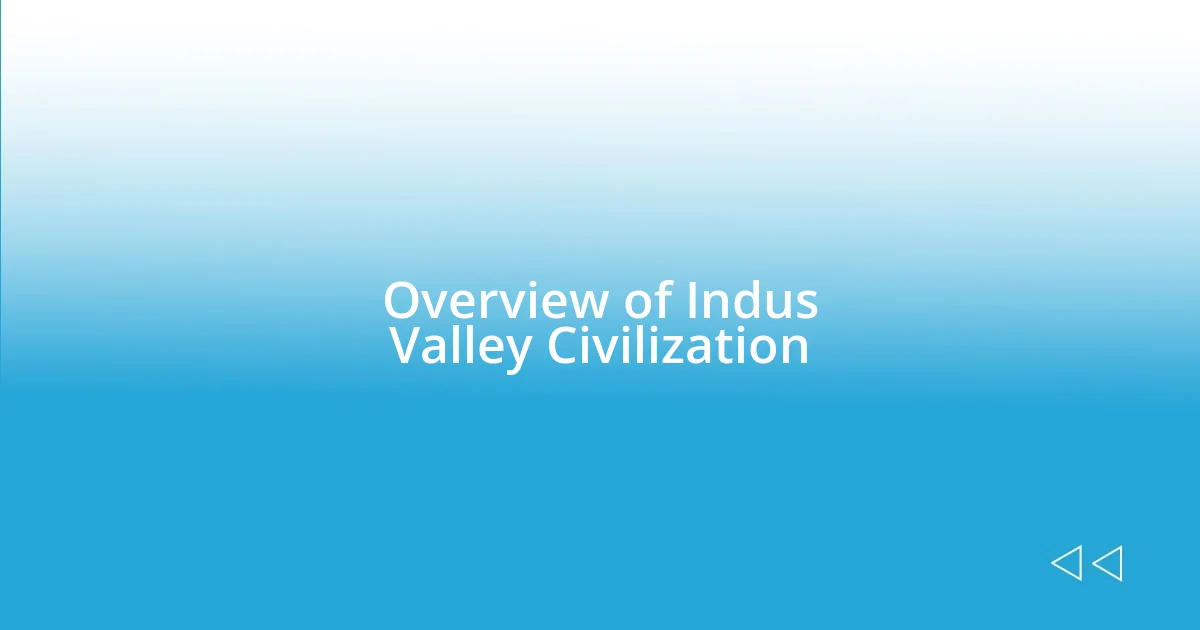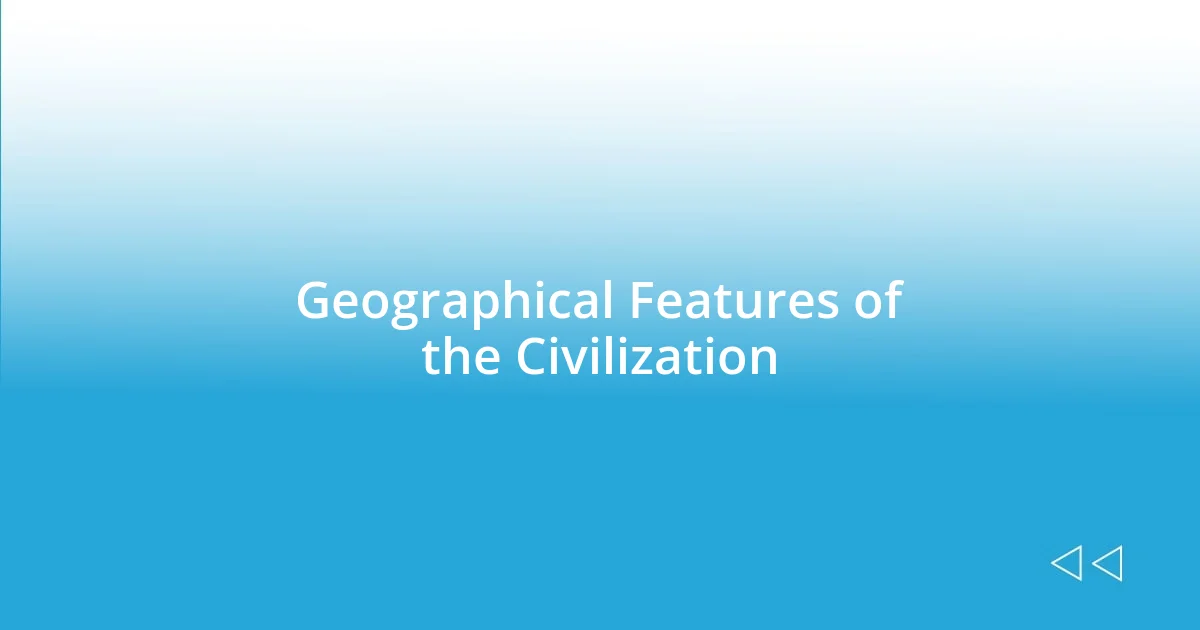Key takeaways:
- The Indus Valley Civilization (2500-1900 BCE) was noted for its advanced urban planning, including sophisticated drainage systems and organized grid layouts in cities like Harappa and Mohenjo-Daro.
- Trade networks connected the civilization to distant regions like Mesopotamia, showcasing a diverse economy and systematized practices, including the use of standardized weights and trade seals.
- Religious practices involved a rich spirituality with reverence for nature, as evidenced by artifacts and public baths that indicate ritual purification played a significant role in their daily lives.

Overview of Indus Valley Civilization
The Indus Valley Civilization, flourishing from about 2500 to 1900 BCE, was one of the oldest urban cultures in the world, primarily located in what is now Pakistan and northwest India. I often marvel at the advanced city planning of Harappa and Mohenjo-Daro, especially considering how they had sophisticated drainage systems and grid layouts—can you believe that was happening millennia ago?
I remember reading about the vibrant trade networks they established, connecting them with distant regions like Mesopotamia. It’s fascinating to think about how these interactions shaped their society, culture, and even economies. Imagine the bustling markets filled with artisans crafting goods, traders exchanging not just items but ideas as well.
What truly intrigues me is the mystery surrounding their writing system, which remains undeciphered. Can you imagine a civilization that left behind clues to their thoughts and stories, yet we’re unable to fully unlock their secrets? This enigma adds a deeper layer to our understanding of them—creating a sense of connection and curiosity about lives lived thousands of years ago.

Geographical Features of the Civilization
The Indus Valley Civilization was uniquely shaped by its geographical features, which played a critical role in its development. Nestled between the mighty Indus River and its tributaries, the region was blessed with fertile land that supported agriculture. I often picture how these early farmers must have felt, seeing their crops flourish where the soil met the life-giving waters—a true testament to the power of nature to nurture communities.
- Indus River: The river served as the lifeblood of the civilization, fostering agricultural abundance and trade.
- Floodplains: These areas provided rich soil due to seasonal flooding, making them ideal for sustainable farming.
- Natural Barriers: The surrounding mountains and deserts offered protection from invasions but also limited interactions with other cultures.
- Climate: A largely semi-arid climate with seasonal rainfall influenced farming practices and settlement patterns.
I can’t help but admire how the inhabitants adapted to their environment. The strategic placement of their cities along rivers not only provided water but also created avenues for trade. When I think about how they engineered their homes using locally sourced materials, it evokes a sense of ingenuity that is deeply inspiring.

Socioeconomic Structure and Trade Practices
The socioeconomic structure of the Indus Valley Civilization was intricate and quite fascinating. From what I’ve gathered, it appears that society was relatively egalitarian compared to other ancient civilizations, with a diverse range of occupations. I often think about how artisans, farmers, and traders all played vital roles, creating a vibrant community where skills were passed down through generations—almost like a crafting family tradition. Can you imagine the pride those artisans must have felt when showcasing their beautifully crafted jewelry or pottery?
Trade practices among the Indus people were remarkably sophisticated for their time. The existence of standardization in weights and measures indicates a systematic approach to trade, which I find particularly impressive. This efficiency probably facilitated exchanges with regions as far as Mesopotamia, and I can almost envision lively marketplaces bustling with discussions over goods like cotton textiles and precious metals, fostering not only economic growth but cultural exchanges.
It’s worth noting the role of trade seals, which were used to mark ownership and trade items. These small yet significant artifacts give us insights into their commerce and social organization. I remember reading about how these seals, often engraved with unique motifs, acted as a form of identity and branding in their day. Can you see how such a practice resonates with today’s branding in business? It’s all about connection—whether between cultures or within communities.
| Aspect | Indus Valley Civilization |
|---|---|
| Occupational Diversity | Artisans, farmers, traders |
| Trade Networks | Connected to Mesopotamia |
| Standardization of Weights | Facilitated trade efficiency |
| Seals | Used for ownership and branding |

Urban Planning and Architecture Insights
The urban planning of the Indus Valley Civilization showcases an impressive grasp of architecture and organization that still intrigues me today. It’s fascinating to think about how cities like Harappa and Mohenjo-Daro were laid out with meticulous attention to grid patterns, which seems so modern. I can’t help but wonder about the engineers and planners behind this, visualizing them sketching out their designs on clay tablets and tirelessly working to create such a harmonious living space.
What strikes me most is the advanced drainage system they developed. They constructed covered drains that ran along the streets, with brick-lined channels for stormwater. Imagine the pride of those residents, knowing their homes were not only well-designed but also equipped to handle monsoon rains. To me, this innovation reflects a deep understanding of urban hygiene and public health that was far ahead of its time, reminding me of the importance of infrastructure in our own cities today.
Moreover, the use of baked bricks standardized across the region is a testament to their architectural prowess. The uniformity in construction material not only facilitated trade but also gave their cities a distinctive look. I often reflect on how this unifying feature can enhance a community’s identity. Can you picture strolling through a neighborhood where every building tells a story of craftsmanship and tradition? It’s a reminder that good architecture can foster a sense of belonging, echoing across centuries and connecting us to the past.

Religion and Spiritual Life Explained
Religion and spirituality in the Indus Valley Civilization reveal a unique tapestry of beliefs and practices that pique my curiosity. Though we don’t have written records from that era, archaeological findings suggest a rich spiritual life, with evidence of figurines and seals depicting potential deities or sacred animals. Walking through museums, I often find myself captivated by these artifacts—they seem to whisper the stories of ancient worship and rituals that were once integral to daily life.
It’s intriguing to me how the possible reverence for nature is reflected in their art and symbols. Some seals feature motifs of a horned figure that some scholars believe could represent a god, possibly connected to fertility or agriculture. I can almost envision communities gathering to celebrate the cycles of planting and harvest, invoking blessings for a bountiful yield. What were those moments like? Picture the aroma of fresh earth and crops, lingering in the air as families came together in shared faith and hope.
Moreover, the presence of large public baths, like the Great Bath at Mohenjo-Daro, suggests that ritual purification was a vital aspect of their spiritual life. I often ponder what it must have felt like to step into water believed to be sanctifying, the coolness washing away not just the dirt, but perhaps fears and worries too. Isn’t it fascinating to think that even in ancient times, human beings sought moments of communion and reflection—practices that resonate with us in our spiritual journeys today?
















